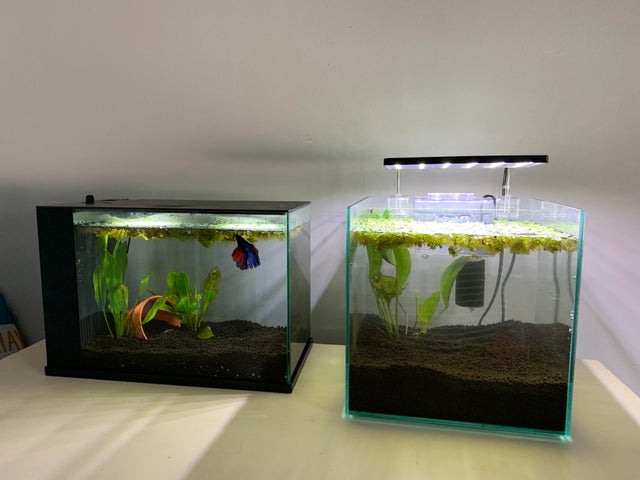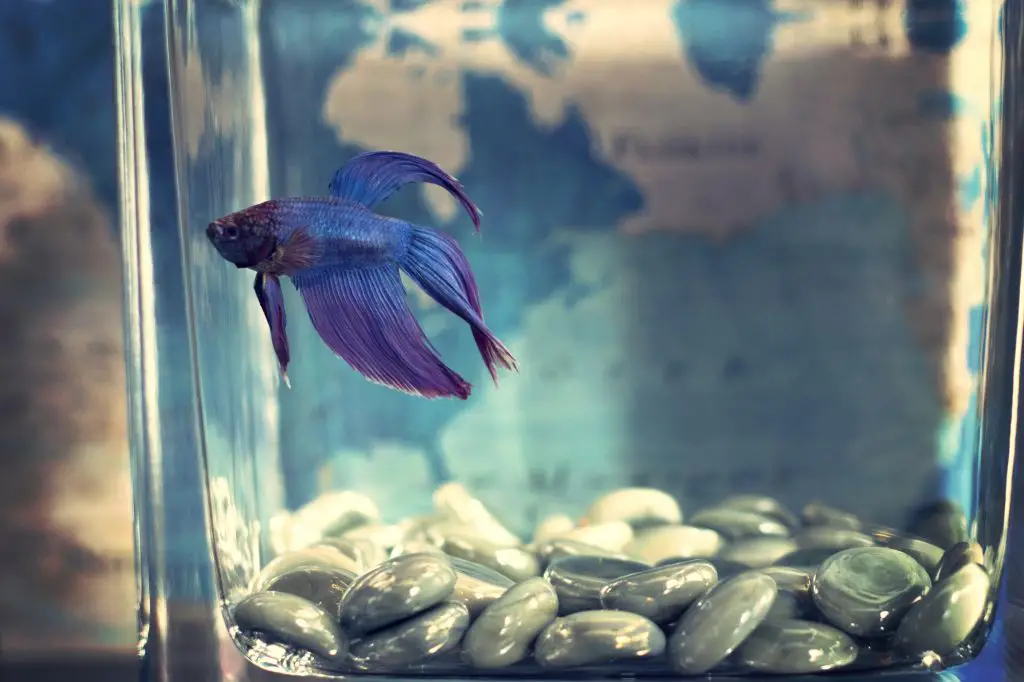Are you considering getting a betta fish as your new aquatic pet? Before you make any decisions, it’s important to know whether a 3-gallon tank is a suitable home for your betta.
While some people argue that 3 gallons is enough space for a betta to live comfortably, others believe that a larger tank is necessary for their wellbeing. In this article, we’ll explore the factors that determine whether a betta fish can thrive in a 3-gallon tank and what you need to consider before making a final decision.

Can a Betta Fish Live in a 3 Gallon Tank?
Betta fish, also known as Siamese fighting fish, are a popular choice for aquarium enthusiasts. These colorful fish are known for their aggressive behavior, which makes them a fascinating addition to any aquarium. However, one of the most common questions is whether a betta fish can live in a 3 gallon tank.
What are the Ideal Tank Requirements for Betta Fish?
The ideal tank size for a betta fish is 5 gallons or more. A 3 gallon tank is on the lower end of the spectrum, but it is still possible to keep a betta fish in this size of the tank. However, it is important to keep in mind that a 3 gallon tank will require more maintenance and careful attention to keep the water quality at optimal levels.
In addition to the tank size, it is important to consider the tank shape as well. Betta fish require a tank that is long and shallow rather than tall and narrow. This is because betta fish like to swim horizontally rather than vertically.
Benefits of a 3 Gallon Tank for Betta Fish
While a 3 gallon tank is not the ideal size for a betta fish, there are some benefits to keeping a betta fish in a smaller tank. First and foremost, a smaller tank takes up less space, making it a great option for those who have limited space in their homes. Additionally, a smaller tank is easier to maintain, as there is less water volume to clean and fewer decorations to manage.
Another benefit of a 3 gallon tank is the cost. A smaller tank is generally less expensive than a larger tank, making it a great option for those who are on a budget.
The Drawbacks of a 3 Gallon Tank for Betta Fish
While there are some benefits to keeping a betta fish in a 3 gallon tank, there are also some drawbacks to consider. One of the biggest drawbacks is the limited swimming space. Betta fish are active swimmers and require ample space to move around. A 3 gallon tank may not provide enough space for the fish to swim and explore.
Another drawback is the difficulty in maintaining water quality. A smaller tank has a smaller volume of water, which means that any changes in water quality can have a greater impact on the health of the fish. This means that a 3 gallon tank requires more frequent water changes and careful monitoring of the water quality.
How to Make a 3 Gallon Tank Suitable for Betta Fish
If you decide to keep a betta fish in a 3 gallon tank, there are several things you can do to make the tank suitable for the fish. First, make sure that the tank is long and shallow rather than tall and narrow. This will provide the fish with more swimming space.
Next, consider adding live plants to the tank. Live plants can help to improve water quality by absorbing nitrates and other harmful chemicals. They also provide a natural environment for the fish.
Finally, make sure to keep up with regular water changes and monitor the water quality closely. A 3 gallon tank requires more frequent water changes than a larger tank, so it is important to stay on top of maintenance.
3 Gallon Tank vs. Larger Tanks
While it is possible to keep a betta fish in a 3 gallon tank, it is important to consider a larger tank if possible. A larger tank provides more swimming space for the fish, which is important for their health and well-being. Additionally, a larger tank is easier to maintain and provides more room for decorations and live plants.
Overall, a 3 gallon tank can be a suitable option for a betta fish, but it requires more maintenance and careful attention to keep the water quality at optimal levels. If possible, it is recommended to consider a larger tank for these fascinating and beautiful fish.
| Benefits of a 3 Gallon Tank | Drawbacks of a 3 Gallon Tank |
|---|---|
| Less expensive | Limited swimming space |
| Easier to maintain | Difficulty in maintaining water quality |
| Great for those with limited space |
- The ideal tank size for a betta fish is 5 gallons or more.
- A 3 gallon tank requires more frequent water changes and careful attention to maintain water quality.
- A smaller tank is generally less expensive than a larger tank.
- Betta fish require a tank that is long and shallow rather than tall and narrow.
- A 3 gallon tank is easier to maintain, as there is less water volume to clean and fewer decorations to manage.
- Betta fish are active swimmers and require ample space to move around.
- A smaller tank takes up less space, making it a great option for those who have limited space in their homes.
- Live plants can help to improve water quality by absorbing nitrates and other harmful chemicals.
- A larger tank provides more swimming space for the fish, which is important for their health and well-being.
- If possible, it is recommended to consider a larger tank for betta fish.
Frequently Asked Questions
Many people wonder if a betta fish can live in a 3-gallon tank. Here are some common questions and answers regarding this topic.
Can a betta fish live in a 3-gallon tank?
Yes, a betta fish can live in a 3-gallon tank, but it may not be the ideal living situation for them. Betta fish need space to swim and explore, and a 3-gallon tank may not provide enough room. Additionally, the water in a smaller tank can become dirty faster, leading to poor water quality for the fish.
If you decide to keep a betta fish in a 3-gallon tank, it’s important to keep up with regular water changes and provide plenty of hiding places and decorations for the fish to explore. A larger tank would be a better option for betta fish, but a 3-gallon tank can work if properly maintained.
What are the best tank conditions for a betta fish?
Betta fish thrive in a tank with a minimum of 5 gallons of water. The water should be heated to a temperature between 78-82 degrees Fahrenheit and filtered to keep it clean and healthy for the fish. Betta fish also prefer a tank with plenty of hiding places, such as plants and decorations, and a gentle current.
It’s important to keep up with regular water changes and tank maintenance to ensure a healthy living environment for your betta fish. Overfeeding the fish can also lead to poor water quality, so be sure to feed them a balanced diet and monitor their food intake.
What should I feed my betta fish?
Betta fish are carnivores and should be fed a diet of high-quality fish food that is specifically formulated for betta fish. They enjoy a varied diet that includes pellets, frozen or live bloodworms, and brine shrimp. It’s important to avoid overfeeding your betta fish, as this can lead to poor water quality and health issues for the fish.
Feed your betta fish small amounts of food twice a day, and monitor their food intake to ensure they are not being overfed. A balanced diet will help keep your betta fish healthy and happy.
Can betta fish live with other fish?
Betta fish are known for their aggressive nature and should not be kept in a tank with other fish, especially other male bettas. Male bettas will fight with each other, often to the death, and even female bettas can be aggressive towards other fish.
If you want to keep other fish in the same tank as your betta fish, it’s important to choose fish that are peaceful and won’t provoke the betta. Some good tankmates for betta fish include snails, shrimp, and small schooling fish like neon tetras or guppies.
How often should I clean my betta fish’s tank?
Your betta fish’s tank should be cleaned regularly to maintain good water quality. How often you clean the tank will depend on the size of the tank and the number of fish in it. As a general rule, a 3-gallon tank should be cleaned once a week, while a larger tank may only need to be cleaned once a month.
During a tank cleaning, remove any uneaten food, debris, and excess algae from the tank. Replace a portion of the water with fresh, treated water and rinse any decorations or plants in the tank. It’s important not to clean the tank too frequently, as this can disrupt the balance of good bacteria in the tank that help keep the water clean.

Betta tank 3 Gallon, 4 Months Update
In conclusion, the answer to whether a betta fish can live in a 3-gallon tank is not a straightforward one. While it is possible for a betta to survive in a 3-gallon tank, it is not an ideal living environment for them.
Betta fish require adequate space to swim around and explore, as well as a proper filtration system to maintain water quality. A 3-gallon tank may not provide enough space for these active fish to thrive, and the water can become polluted quickly without the appropriate filtration.
As responsible pet owners, it is our duty to provide our pets with the best possible living conditions. Although a 3-gallon tank may be a convenient option, it is not the most suitable choice for a betta fish. Investing in a larger tank and proper filtration will ensure that your betta lives a long and healthy life.
